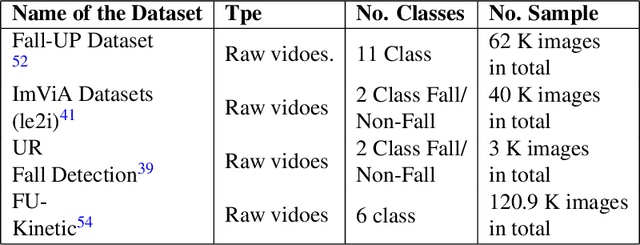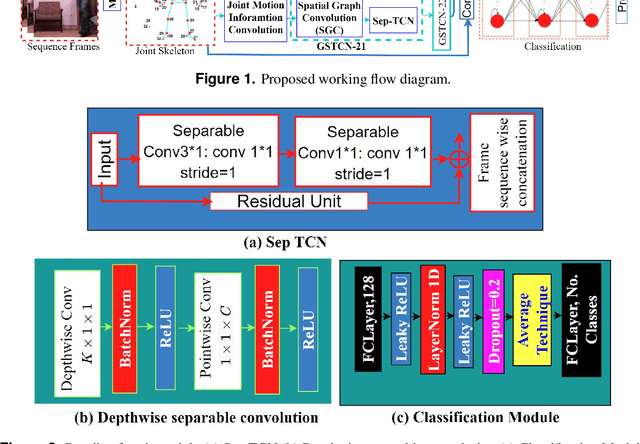Yoichi Tomioka
Computer-Aided Fall Recognition Using a Three-Stream Spatial-Temporal GCN Model with Adaptive Feature Aggregation
Aug 22, 2024



Abstract:The prevention of falls is paramount in modern healthcare, particularly for the elderly, as falls can lead to severe injuries or even fatalities. Additionally, the growing incidence of falls among the elderly, coupled with the urgent need to prevent suicide attempts resulting from medication overdose, underscores the critical importance of accurate and efficient fall detection methods. In this scenario, a computer-aided fall detection system is inevitable to save elderly people's lives worldwide. Many researchers have been working to develop fall detection systems. However, the existing fall detection systems often struggle with issues such as unsatisfactory performance accuracy, limited robustness, high computational complexity, and sensitivity to environmental factors due to a lack of effective features. In response to these challenges, this paper proposes a novel three-stream spatial-temporal feature-based fall detection system. Our system incorporates joint skeleton-based spatial and temporal Graph Convolutional Network (GCN) features, joint motion-based spatial and temporal GCN features, and residual connections-based features. Each stream employs adaptive graph-based feature aggregation and consecutive separable convolutional neural networks (Sep-TCN), significantly reducing computational complexity and model parameters compared to prior systems. Experimental results across multiple datasets demonstrate the superior effectiveness and efficiency of our proposed system, with accuracies of 99.51\%, 99.15\%, 99.79\% and 99.85 \% achieved on the ImViA, UR-Fall, Fall-UP and FU-Kinect datasets, respectively. The remarkable performance of our system highlights its superiority, efficiency, and generalizability in real-world fall detection scenarios, offering significant advancements in healthcare and societal well-being.
YOLIC: An Efficient Method for Object Localization and Classification on Edge Devices
Jul 30, 2023



Abstract:In the realm of Tiny AI, we introduce ``You Only Look at Interested Cells" (YOLIC), an efficient method for object localization and classification on edge devices. Through seamlessly blending the strengths of semantic segmentation and object detection, YOLIC offers superior computational efficiency and precision. By adopting Cells of Interest for classification instead of individual pixels, YOLIC encapsulates relevant information, reduces computational load, and enables rough object shape inference. Importantly, the need for bounding box regression is obviated, as YOLIC capitalizes on the predetermined cell configuration that provides information about potential object location, size, and shape. To tackle the issue of single-label classification limitations, a multi-label classification approach is applied to each cell for effectively recognizing overlapping or closely situated objects. This paper presents extensive experiments on multiple datasets to demonstrate that YOLIC achieves detection performance comparable to the state-of-the-art YOLO algorithms while surpassing in speed, exceeding 30fps on a Raspberry Pi 4B CPU. All resources related to this study, including datasets, cell designer, image annotation tool, and source code, have been made publicly available on our project website at https://kai3316.github.io/yolic.github.io
Big Data - Supply Chain Management Framework for Forecasting: Data Preprocessing and Machine Learning Techniques
Jul 24, 2023Abstract:This article intends to systematically identify and comparatively analyze state-of-the-art supply chain (SC) forecasting strategies and technologies. A novel framework has been proposed incorporating Big Data Analytics in SC Management (problem identification, data sources, exploratory data analysis, machine-learning model training, hyperparameter tuning, performance evaluation, and optimization), forecasting effects on human-workforce, inventory, and overall SC. Initially, the need to collect data according to SC strategy and how to collect them has been discussed. The article discusses the need for different types of forecasting according to the period or SC objective. The SC KPIs and the error-measurement systems have been recommended to optimize the top-performing model. The adverse effects of phantom inventory on forecasting and the dependence of managerial decisions on the SC KPIs for determining model performance parameters and improving operations management, transparency, and planning efficiency have been illustrated. The cyclic connection within the framework introduces preprocessing optimization based on the post-process KPIs, optimizing the overall control process (inventory management, workforce determination, cost, production and capacity planning). The contribution of this research lies in the standard SC process framework proposal, recommended forecasting data analysis, forecasting effects on SC performance, machine learning algorithms optimization followed, and in shedding light on future research.
 Add to Chrome
Add to Chrome Add to Firefox
Add to Firefox Add to Edge
Add to Edge